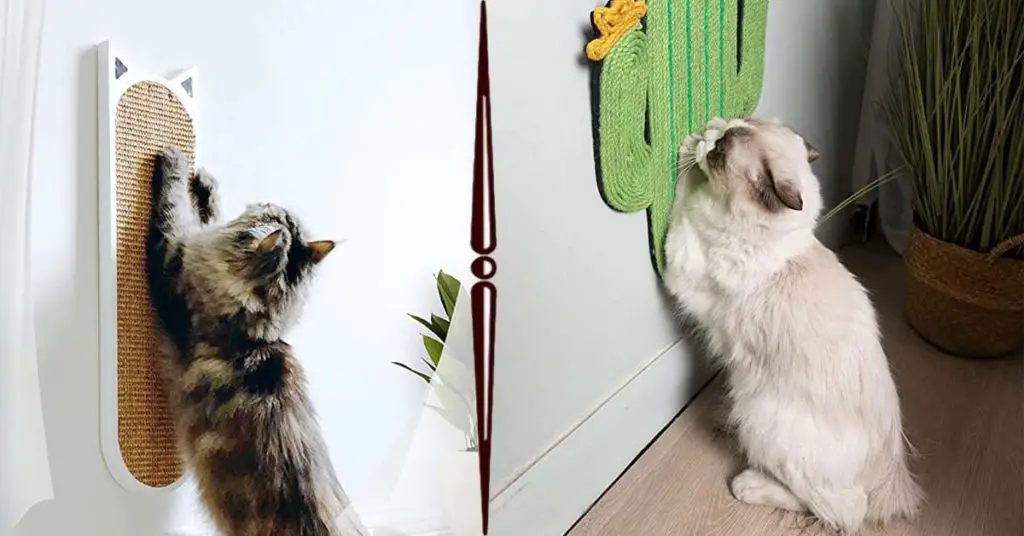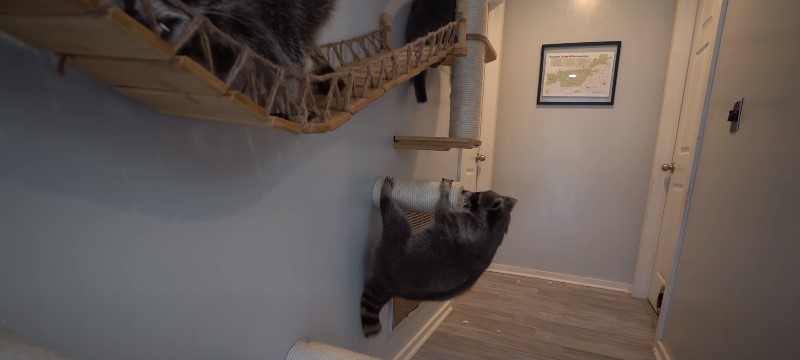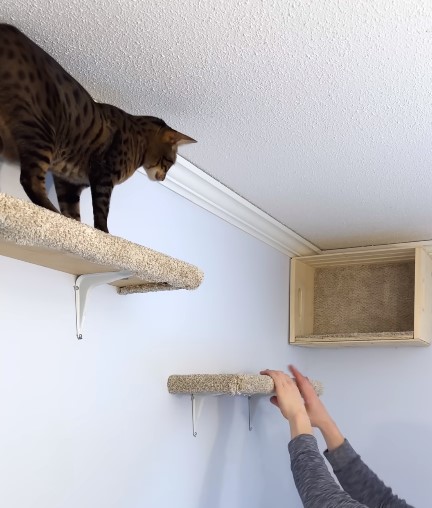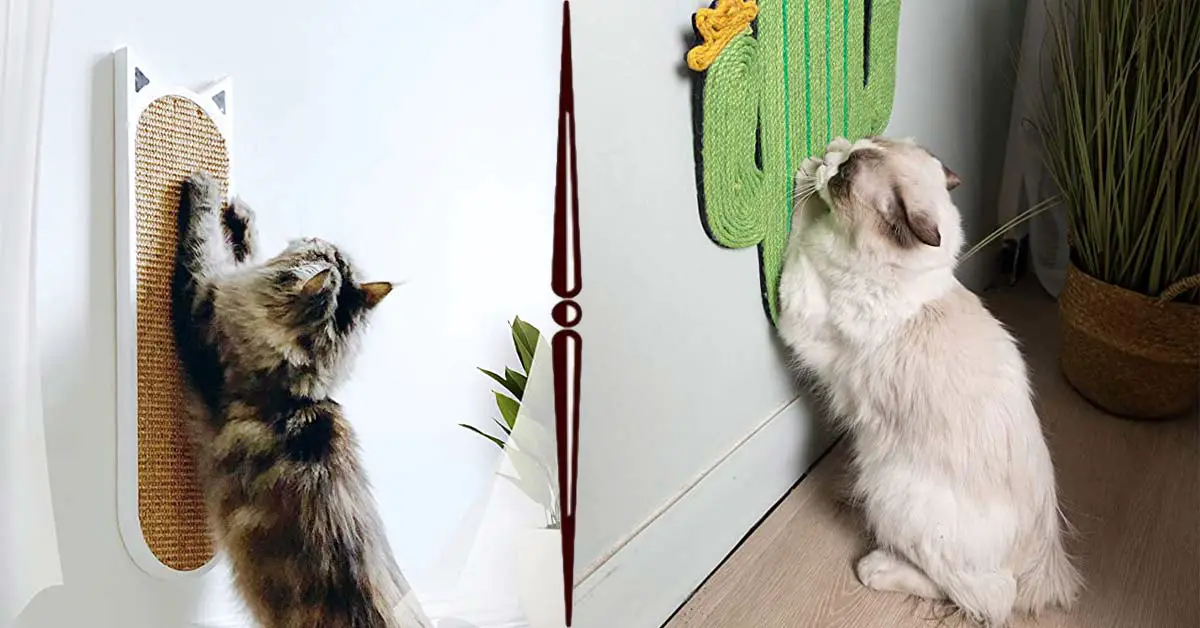If you’re a cat owner, you know how important it is to keep your feline friend entertained. Cats love scratching, but traditional scratchers can take up a lot of room.
That’s where hanging cat scratchers come in. These clever vertical PlayStations are a fantastic solution. They save space and provide endless fun for your furry companion.
What is a Hanging Cat Scratcher?

A hanging cat scratcher is a type of cat scratcher that is attached to a doorknob or other vertical surface. It is typically made of durable material, such as sisal or cardboard, and has a rough surface that cats enjoy scratching.
Hanging cat scratchers are a good option for cats who like to scratch in high places, and they can help to protect your furniture from damage.
There are many types of scratchers like Sisal rope scratchers, cardboard, scratcher mat, Carpeted scratchers, cactus scratching post, scratcher boards, foldable scratchpads, wall mounted scratcher, vertical scratching post and Multi-level scratchers, etc.
Wall-mounted or hanging scratchers attach to the wall or can be used horizontally on the floor. A good scratching post will make your cat busy and keep healthy by doing exercise on it.
Hanging Cat Scratcher – The Good
Hanging cat scratchers are like mini play areas for our cats. They usually hang on a wall or a door and let cats scratch upward, mimicking the way they scratch trees in the wild. There are some really cool things about hanging scratchers:
1. Vertical Scratching Simulation
Cats love to stretch and scratch things vertically. Hanging scratchers let them do just that! When cats scratch, they’re not only taking care of their claws, they’re also marking their territory. With a hanging scratcher, they can do this comfortably.
2. Space-Saving and Versatile
If you live in a small apartment, you know that space is precious. Hanging scratchers don’t take up floor space like traditional ones.
They can be attached to walls or doors, making them perfect for tight spaces. Plus, you can put them at different heights to match your cat’s preferences.
3. Entertainment and Exercise
Cats are curious creatures. Hanging scratchers often come with toys attached, like feathers or bells. This makes scratching time even more fun for your feline friend.
Also, when cats play on a hanging scratcher, they’re getting some exercise too, which is great for their health.
4. Reducing Furniture Damage
Cats don’t scratch just to annoy us. They scratch because it’s a natural behavior that helps them stay happy. But sometimes, they scratch furniture, which can be frustrating for us.
Hanging scratchers give them a better option. If they have a cool scratcher, they’re less likely to turn your couch into their personal nail salon.

Hanging Cat Scratcher – The Bad
While hanging cat scratchers have lots of good points, there are some things that might not make them the best choice for every cat and owner:
1. Not Suitable for All Cats
Not all cats are the same. Some might not enjoy scratching on a hanging scratcher. They might prefer the feel of a horizontal scratcher or a different texture. It’s important to pay attention to your cat’s preferences.
2. Installation Challenges
Putting up a hanging scratcher might sound easy, but it can sometimes be tricky. You need to make sure it’s stable and won’t fall when your cat uses it. This might require some tools and skills that not everyone has.
3. Limited Scratching Angles
Hanging scratchers usually offer a vertical scratching surface. But cats also like to scratch at different angles. Traditional scratchers give them more options in this regard.
4. Durability Concerns
Some hanging scratchers might not be very durable. Cats can be quite rough with their scratching, and if the scratcher falls apart quickly, it won’t be very useful.
Homemade Hanging Cat Scratcher – Benefits and How-Tos
Making your own hanging cat scratcher can be a fun project. Here’s why it’s a good idea and how you can do it:
1. Why Consider Making Your Own?
Cost-Effectiveness: Store-bought scratchers can sometimes be expensive. Making your own can be a budget-friendly option.
Customization: Every cat is unique. When you make your own scratcher, you can tailor it to your cat’s preferences. You can choose the materials they like and even add their favorite toys.
Eco-Friendly: If you’re into recycling, making a scratcher from materials you already have is a great way to help the environment.
2. Materials and Tools Needed
For a simple hanging scratcher, you’ll need the things below. You can find these items at most hardware stores.

- Wooden Board or Cardboard: Choose a sturdy wooden board or a piece of thick cardboard. The size and shape of the board will depend on your preference and available space.
- Strong Rope or Twine: Opt for a natural fiber rope or twine that your cat can easily grip and scratch. Sisal rope works well and is readily available.
- Drill: You’ll need a drill to make holes in the board for attaching the rope.
- Screws and Anchors: Choose screws that are appropriate for the thickness of your board and the type of wall you’ll be attaching the scratcher. If needed, use wall anchors for added stability.
- Toys or Bells: Adding some interactive elements like hanging toys or bells can make the scratcher more appealing to your cat.
3. Step-by-Step Guide
Step 1: Design Your Scratch Area
Decide on the size and shape of your scratcher. Cut the wooden board or cardboard to your desired dimensions. You can go for a rectangular shape or get creative with curves or angles.
Step 2: Drill Holes for Rope
Using the drill, make evenly spaced holes along the top edge of the board. These holes will be used to thread the rope through, so make sure they’re large enough to accommodate the rope’s thickness.
Step 3: Attach the Rope
Start by threading one end of the rope through a hole from the backside of the board. Leave enough rope to hang the scratcher securely.
Tie a knot on the front side to prevent the rope from slipping back through the hole. Repeat this process for each hole, creating a series of loops.
Step 4: Secure the Rope
On the backside of the board, tie a secure knot at the end of each rope, so they won’t pull through the holes. These knots will keep the scratcher stable and prevent it from sagging.
Step 5: Decorate the Scratcher
If you want to make the scratcher more enticing, you can attach hanging toys, feathers, or bells to the ropes. Cats love interactive elements, and these additions can make the scratcher even more appealing.
Step 6: Choose a Hanging Spot
Decide where you want to hang the scratcher. It could be on a wall, door, or any other vertical surface that’s easily accessible to your cat.
Step 7: Install the Scratcher
Hold the scratcher against the chosen surface and mark the positions of the holes on the wall. Use a level to make sure the scratcher will hang straight.
Drill holes into the wall and insert anchors if needed. Then, screw the scratcher onto the wall using the marked holes.
Step 8: Test the Stability
Before letting your cat explore the scratcher, gently pull on the ropes to ensure the scratcher is securely attached to the wall. You want to make sure it can withstand your cat’s scratching and playing.
Step 9: Introduce Your Cat
Show your cat the new scratcher and encourage them to explore it. You can gently scratch the rope with your fingers to demonstrate how it works. Sprinkle some catnip on the scratcher to make it even more appealing.
4. Monitor and Maintenance
Keep an eye on the scratcher’s condition. If the rope gets frayed or the toys come loose, fix them promptly. Cats enjoy scratchers that are in good shape. Regular maintenance will keep the scratcher safe and enjoyable for your cat.
FAQ’s
Is hanging cat scratchers safe for cats?
Yes, hanging cat scratchers are safe for cats. Cats need to scratch to keep their claws healthy and to relieve stress. A hanging cat scratcher provides a safe place for your cat to scratch without damaging your furniture.
How do you mount a cat scratching post?
First, find a suitable location for the cat scratching post. It should be close to where your cat spends most of its time. Once you have found the perfect spot, use a drill to make pilot holes in the wall.
Next, insert the wall plugs and screw in the screws. Finally, attach the cat scratching post to the wall using the screws and wall plugs.
What rope should I use for a cat scratching post?
You can use any rope for a cat scratching post, but sisal rope is the best option because it’s natural and rough, which is perfect for cats to scratch.
How do hanging cat scratchers work?
Hanging cat scratchers work by providing a vertical surface for cats to scratch on. They are typically attached to walls or doors and feature a textured material like sisal rope or carpet.
Cats can dig their claws into the surface, satisfying their natural scratching instincts and keeping their claws healthy.
Are hanging cat scratchers suitable for all cat breeds?
Yes, hanging cat scratchers are suitable for cats of all breeds and sizes. However, it’s important to choose a scratcher that is large enough and stable to accommodate your cat’s size and weight.
Consider your cat’s preferences for scratching surfaces (vertical or horizontal) when selecting a hanging scratcher.
Can I install a hanging cat scratcher in an apartment?
Absolutely! Hanging cat scratchers are ideal for apartments and smaller living spaces. They save valuable floor space and can be easily mounted on walls or doors.
Just ensure that you have permission from your landlord if required, and choose a scratcher that can be securely attached without causing damage to the walls or doors.
How often should I replace a hanging cat scratcher?
The lifespan of a hanging cat scratcher depends on its quality, durability, and your cat’s scratching habits. Generally, it is recommended to replace the scratcher when it becomes worn out or no longer provides a satisfying scratching experience for your cat.
Observing signs of excessive fraying, loose threads, or significant wear and tear is a good indicator that it’s time for a replacement.
His professional interests include humane education, ethics, small animal behavior, and veterinary. As a pet lover from school life, having grown up with two cats and a dog. If he isn’t spending time with his friends and family, Justin enjoys traveling. Learn more about Justin here.
Find him on: Facebook
Read his latest ARTICLES

